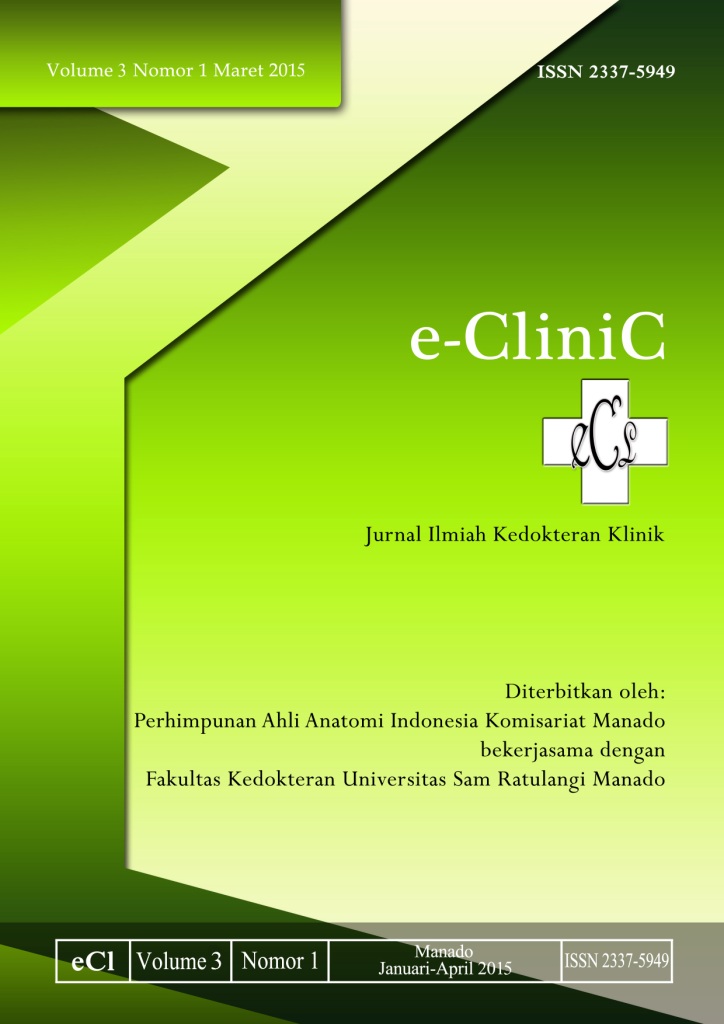PROFIL PIODERMA PADA ORANG DEWASA DI POLIKLINIK KULIT DAN KELAMIN RSUP PROF. DR. R. D. KANDOU MANADO TAHUN 2012
DOI:
https://doi.org/10.35790/ecl.v3i1.7486Abstract
Abstract: Pyoderma is the most common skin-bacterial disease caused by infection. The main causes of pyoderma are staphylococcus aureus and streptococcus sp. Pyoderma can occur among females or males of any ages. Generally, pyoderma is influenced by nutrient state, skin integrity, immunologic condition, and environmental condition inter alia heat, humidity, as well as poor sanitation and hygiene. This study aimed to obtain the profil of pyoderma at Dermato-venereology Department, Prof. Dr. R. D. Kandou General Hospital Manado from January to December 2012. This was a retrospective study using data of pyoderma patient medical records Prof. Dr. R. D. Kandou Hospital Manado within January-December 2012. The results showed that the occurence of pyoderma in 2012 was 1.09% (44 cases), most were females 52.3% (23 cases), and aged 45-46 years 52,3% (23 cases). Cellulitis is a type of pyoderma which occured 52.3% (23 cases). Clindamycin is a systemic antibiotic which was used the most, 65.9% (29 cases), and topical antibiotic which was mostly used was fucidic acid 31.8% (14 cases). Conclusion: Cellulitis was the most common case found, in females were more than in males, aged 45-64 years old. Clindamycin was the mostly used systemic antibiotics, while the topical one was fucidic acid.
Keywords: skin infected disease, adult, pyoderma
Abstrak: Pioderma adalah penyakit infeksi bakterial kulit yang paling sering ditemukan. Penyebab utama pioderma ialah bakteri staphylococcus aureus maupun streptococcus sp. Pioderma dapat menyerang laki-laki maupun perempuan pada semua usia. Terjadinya pioderma umumnya dipengaruhi oleh gizi, integritas kulit, kondisi imunologis, serta faktor lingkungan seperti panas, kelembaban, kurangnya sanitasi dan higieni. Penelitian ini bertujuan untuk mengetahui profil pasien pioderma pada orang dewasa di poliklinik RSUP Prof. Dr. D. Kandou Manado periode Januari – Desember 2012. Penelitian ini bersifat studi retrospektif menggunakan data catatan medik penderita pioderma yang datang ke poliklinik kulit dan kelamin RSUP Prof. Dr. R. D. Kandou Manado bulan Januari – Desember 2012. Hasil penelitian menunjukkan insiden pioderma tahun 2012 1,09% (44 kasus). Distribusi menurut jenis kelamin terbanyak pada perempuan yaitu 52,3% (23 kasus). Menurut kelompok umur terbanyak pada umur 45-64 tahun yaitu 52,3% (23 kasus). Jenis pioderma terbanyak ialah selulitis 52,3% (23 kasus). Distribusi berdasarkan penggunaan antibiotik sistemik yang terbanyak digunakan ialah klindamisin sebanyak 65,8% (29 kasus), dan atibiotik topikal terbanyak digunakan ialah asam fusidat 31,8% (14 kasus). Simpulan: Selulitis merupakan kelompok kasus terbanyak yang ditemukan, perempuan lebih banyak daripada laki-laki, kelompok umur yang paling banyak terkena ialah 45-64 tahun, antibiotik sistemik yang terbanyak digunakan ialah klindamisin dan untuk penggunaan antibiotik topikal terbayak ialah asam fusidat.
Kata kunci: penyakit kulit infeksi, dewasa, pioderma
Downloads
How to Cite
Issue
Section
License
COPYRIGHT
Authors who publish with this journal agree to the following terms:
Authors hold their copyright and grant this journal the privilege of first publication, with the work simultaneously licensed under a Creative Commons Attribution License that permits others to impart the work with an acknowledgment of the work's origin and initial publication by this journal.
Authors can enter into separate or additional contractual arrangements for the non-exclusive distribution of the journal's published version of the work (for example, post it to an institutional repository or publish it in a book), with an acknowledgment of its underlying publication in this journal.
Authors are permitted and encouraged to post their work online (for example, in institutional repositories or on their website) as it can lead to productive exchanges, as well as earlier and greater citation of the published work (See The Effect of Open Access).







